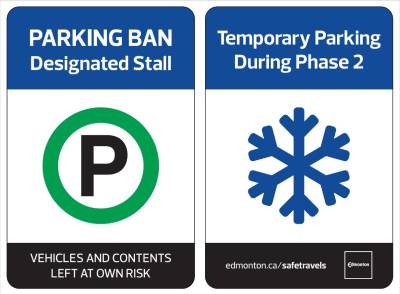The first response to all snowfalls is to apply sand or salt, depending on conditions, to main roads and bus routes. Plowing starts when snow has accumulated on the main roads and the weather forecast calls for continued snowfall.
A variety of factors are taken into account with a focus on safety, including traffic speed, traffic volume, width of the road, and factors in the road design, for example: are there crossroads or hills present that add a unique safety concern to a segment of road? The road priorities as outlined in the current Snow and Ice Control Policy and Snow and Ice Control Procedures are:
- Freeways, arterial roads, business districts
- Collector roads, bus routes
- Local industrial roadways
- Residential streets, alleys
During parking bans, you can use the Snow and Ice Control map to see which phase of the ban streets are part of and the status of clearing as crews complete work.
On main roads, snow is placed in boulevards or left on roads. In cul-de-sacs, snow is stacked in the centre and removed during a clearing operation. No snow is placed in fields or in parks due to environmental concerns.
Snow that gets removed from roads is trucked to one of four snow storage sites (snow dumps).
This action violates municipal bylaws and results in a fine of $250, contributes to unsafe driving and walking conditions, increases the cost of providing winter road maintenance and can lead to blocked storm drains. If you do not have room for snow on your property, you can haul it to one of four approved snow storage facilities (snow dumps) in Edmonton free of charge.
Protected bike lanes are cleared within 24 hours of the end of a snowfall as many of these areas connect with multi-use trails, and are used by many types of users - including pedestrians with strollers, those with mobility devices and cyclists. This level of service is defined in the Snow and Ice Control Policy and Snow and Ice Control Procedures .
Painted bike lanes are cleared at the same time as adjacent main roads to ensure all travellers on busy routes are entitled to the same road maintenance standards, regardless of mode. Painted bike lanes are not cleared to bare pavement, but to the same level of service as the road they are on. Some painted bike lanes connecting two segments of protected bike lanes may be cleared a little faster to ensure safe travel between the two protected bike lane areas.
Snow clearing is a shared responsibility. In order for roads to be cleared efficiently, Edmontonians and the City are partners in helping achieve safe and livable roads in neighbourhoods in the winter.
- Move your cars off the street during parking bans
- Clear your sidewalk as soon as possible, and keep them clear of snow and ice, especially during freeze/thaw cycles
- Work with your neighbours to keep sidewalks clear
- Keep your waste collection areas free of snow and ice
Calcium chloride brine is not used as an anti-icing or deicing agent on roads. Calcium chloride with a corrosion inhibitor is currently only used for the following purposes:
- On City-maintained sidewalks, protected bike lanes and active mobility pathways (including shared use paths) when the conditions require
- As a pre-wetting agent for the sand/salt mix that is dispensed by sanding trucks and sidewalk plows, as it prevents the mixture from freezing prior to being dispensed, results in a more even dispensing of product (less clumping) and improves the adherence of the mixture to road surfaces
Edmonton has some unique challenges: its climate, population density, and the amount of roads and paths that the City is responsible for clearing.
- Edmonton has the third largest amount of roads (by kilometres), behind only Calgary and Toronto
- Edmonton is one of the least-dense cities in Canada at 1,266 people per kilometre squared, falling behind Winnipeg (1,520 people/KM2) and even St. Albert (1,364 people/KM2), but ahead of Regina and Saskatoon
- Edmonton has the third largest budget for winter maintenance, behind Montreal and Toronto, but ahead of Calgary
Using the 311 app or calling 311 is the most effective way to send in a service request to the City. Service requests through 311 are automatically entered into a queue to be prioritized and actioned.
Some notifications are “closed” if crews have been dispatched to action the concern identified in the ticket. In other cases, the City may receive multiple requests about the same area (duplicate requests). In these cases, the duplicate tickets are closed.


 Participating stalls will be identified through signage. If the entire lot is participating, the Participating Lot sign will be visible at each entrance to the lot. You may park in any stall in these lots.
Participating stalls will be identified through signage. If the entire lot is participating, the Participating Lot sign will be visible at each entrance to the lot. You may park in any stall in these lots.